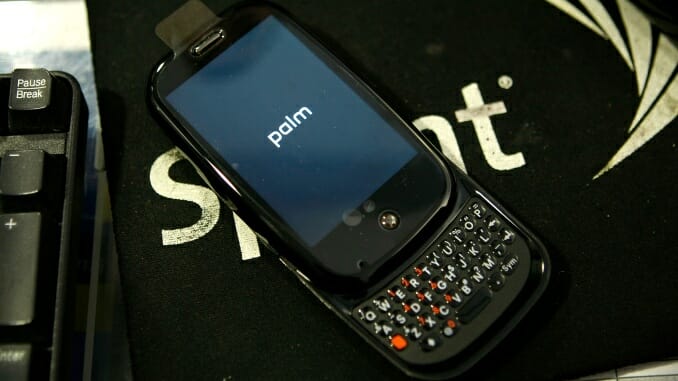Palm pioneered the concept of a personal digital assistant back when only tech-savvy business people or huge geeks carried around the glorified rolodexes decades ago — and took its final, fatal swing at becoming a player in the nascent smartphone market in the mid-aughts.
The company built its reputation on PDAs, but once it became clear that tech was going to be replaced by smartphones, Palm announced its biggest pivot ever around 2007-2008 with the development of the webOS software platform and its Pre line of smartphones. It’d make for one of the most innovative, forward-looking operating systems and cell phone designs of the smartphone era — and it’d also fail miserably when going toe-to-toe with Apple’s iPhone and the diverging Android lines.
Palm thought there could be room for three major players — but fate eventually decided two was enough.
Palm’s push into the smartphone market started out with Jon Rubinstein, the man who helped shepherd the design of Apple’s iPod. Palm recruited Rubinstein to chart the company’s future as a smartphone company with a line of phones running a cutting-edge web-based software platform that used cloud-based features to keep data, a single log-on, and intuitive Synergy software designed to import your contacts and information. Basically all the stuff we take for granted now, just a few years ahead of when everyone else was doing. Pretty much everything about the software and its execution was years ahead of its time, and those early adopters were rewarded with features iPhone and Android users would have to wait years to see them become standard.
The Pre’s operating system was also one of the first mobile platforms to easily allow multitasking, as it kept each separate app in its own “card” so you could rearrange them and flick them away. You know, pretty much how an iPhone works now. The hardware was also extremely clever, evoking the shape of a large pebble, with a touchscreen across the front and hidden, snap-down full physical keyboard. It was also one of the first smartphones to feature gestures (i.e. swipe up for more features, etc.), which pretty much every other manufacturer would eventually add down the line. The Pre even featured wireless charging thanks to a puck-like accessory, years before the feature would become standard.
Considering the timing of the release and the phone’s design, the Pre seemed poised to thread the needle between users wanting something touchscreen and modern in the vein of the iPhone, but with the familiarity of a physical keyboard early smartphone users were accustomed to having. The operating system was incredibly elegant, featuring the ease of use Apple fans expect, with the customization and experimental features that would come to define Android.
But despite the Pre being one of the most advanced smartphones on the market, it was hindered by a few key launch flaws that kept it from gaining traction. The biggest? It launched as a Sprint network exclusive, which severely limited its reach during the buzzy launch window. It took almost a year until the Pre lines were expanded onto the larger Verizon and AT&T networks. The early marketing campaign was also confusing, opting for surreal concept advertisements as opposed to more direct ads showing off the phone’s features.
By the time the Pre and its successors, the Pre Plus and Pre 2, as well as a smaller one-piece model called the Pixi, became widely available, the launch buzz had largely faded. The hardware also struggled to keep up with the operating system and made the phone laggy to use at times. It only really started humming with the later versions.
The final, upgraded Pre 3 limped onto shelves as it was in the process of being canceled, though a few handsets did make it out into the wild internationally. It was simply a limitation of the processing horsepower at the time, and the ambition of the software — but by the time it finally started to catch up — Palm was looking to sell itself for parts to stay afloat.
With the phones not flying off shelves, and Apple already announcing its latest version of the iPhone, Palm and its webOS platform were acquired by HP. For at least a moment, it seemed like HP was keen to make a push into the smartphone market through Palm’s line, launching the webOS-powered TouchPad tablet to compete with the iPad, the Pre 3 and a smaller phone variant dubbed the Veer. The straw that seemingly broke the camel’s back was the TouchPad’s abysmal reception, which saw sales so poor HP announced a fire sale to burn off the remaining stock at the bargain basement price of $99 (several hundreds of dollars down from its $499 launch price) in late 2011 and early 2012. The Pre 3 and Veer were discontinued, and Palm was effectively out of the hardware business.
Interestingly enough, the webOS platform lived on, as HP made the software open source and it has since gone on to power lines of smart TVs from LG (and even smart appliances). Not exactly the revolutionary, world-changing execution the designers likely intended — but webOS does live on. Despite the Pre’s demise, a version of Palm is actually back in the smartphone business. The intellectual property was eventually sold off to TCL, and a rebranded Palm launched a small Android-powered accessory phone in 2018, described as an “ultra-mobile” phone for users who didn’t want to haul their full smartphone around on-the-go (i.e. athletes out running, going for a night out, etc.). It was not well-received and the brand has fallen dormant since.
For a brief moment, Palm was at the top of its game, creating the hardware and software everyone was trying to catch. Now? The Pre line is little more than some cool-looking paperweights, but they’re still fun to play with and marvel how far it really was ahead of its time.
